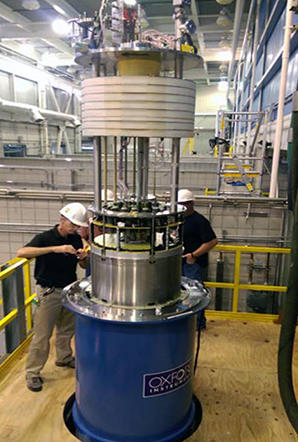8th January 2018
New era in high field superconducting magnets – opening new frontiers in science, nanotechnology and materials discovery
Oxford Instruments is delighted to congratulate our partners at the National High Magnetic Field Laboratory (NHMFL) on the successful demonstration of a 32 Tesla all-superconducting user magnet on 8th of December 2017. Achieving this major milestone is a step change in high field, compact magnets and important for research into new science and materials discovery. It enhances our understanding and knowledge of superconducting and nanomaterials, leading to new nano-devices and applications.
The 32 T superconducting system is made from two primary sections, an outsert section delivering 15 Tesla in a 250 mm wide bore magnet developed by Oxford Instruments Nanoscience (OINS) using advanced Low Temperature Superconductor (LTS) materials operating at 4.2 Kelvin and an insert section delivering 17 Tesla in 34 mm cold bore developed by our colleagues at NHMFL using advanced High Temperature Superconductor (HTS) materials manufactured by Superpower Inc. Both sections were integrated by NHMFL team in a cryogenic system developed by OINS.
There are three particular challenges to overcome in the design and manufacture of such leading-edge superconducting magnets – the stresses within the magnetic coils, the management of the very high stored energy within the magnet and the integration of LTS and HTS coils. To manage the extremely large coil stresses, OINS combined extensive modelling with innovative construction techniques in order to produce the reliable high field LTS coils required.
The energy stored in such a magnet when at its full field is enormous – in this case just under 10 MJ (MegaJoules). Should the magnet “quench” – in other words, rapidly lose its superconductivity – this large stored energy is dissipated safely within just a few seconds. For the LTS outsert of the 32 T magnet, a new quench energy management system was developed and extensively tested before being proven on the full integrated magnet system.
Dr Ziad Melhem, Alliances Manager at OINS said, “We are delighted by the achievement of this milestone in superconducting magnet technology. It is a direct result of working closely with our colleagues and partners at the NHMFL over the last five years at various stages of the product design and development. This sets a new record for superconducting research magnets using LTS and HTS materials. The new magnet system will help accelerate materials research and enable new innovations and discoveries in Nano-materials and Nano-devices”.
The new magnet represents a milestone in magnet design and superconducting materials, a phenomenon that was discovered over a century ago by Professor H Onnes, a Dutch physicist and Nobel Laureate, and led to the first commercial superconducting magnet by Oxford Instruments in 1960, followed by Oxford Instruments developing the first commercial Magnetic Resonance Imaging (MRI) systems for medical applications in 1970.
The Project Leader Dr Huub Weijers commented, “In this project we have explored new territory in magnet science and arrived at a magnet that met all specifications the first time is was brought to full field. That is only possible when you have a well thought out concept, as developed in this case by Denis Markiewicz, and a great team that can handle the wide range of tasks the project requires, and tackle each and every problem that comes along. Our industry partners have been an integral part of the team, and we were all committed to delivering a great product even if wasn’t necessarily clear ahead of time what it all would take. I think we can be happy with both the results, and the collaborative way in which we have been able to achieve them”.
Superconductors are advanced materials that conduct electricity with no heat losses, unlike copper, in which electrons encounter lots of friction and lead to heat losses and require massive power and cooling to enable high fields. Until now, all superconducting magnets are made from LTS materials limiting the performance to 24 Tesla. But in 1986, scientists discovered the first HTS material that can operate at warmer temperatures and in high magnetic fields greater than 24 Tesla. When HTS was first discovered, it created a tremendous stir in the science community and led to the nobel-prize winning.
Dr Michael Cuthbert, Commercial Director of OINS said, “The completion of this magnet is confirmation of Oxford Instruments’ world-class capability to develop state-of-the-art, high field superconducting magnet systems. Our strong track record in the development and manufacture of unique superconducting magnet products is underpinned by our commitment to enable our customers to push the boundaries of their research and facilitate National Facility grade performance of high magnetic field in compact lab scale environment”.
"We greatly value our partnership with Oxford Instruments Nanoscience," said NHMFL Director Dr Greg Boebinger. "We celebrate together this new paradigm of integrating HTS and LTS coils with novel quench-protection technology to create a revolutionary 32 T magnet suitable for a wide range of scientific experiments. These are exciting times."
High field in combination with low temperature is a crucial aid in studying, modifying and control new states of matter. High magnetic fields are needed by the research community in physical and life sciences to explore new areas in nanoscience, nanotechnology, and bioscience and materials research. Superconducting magnets provide high magnetic fields without the enormous power consumption and large infrastructure requirements of resistive magnets. The 32 Tesla compact magnet will enable new discoveries and innovations in advanced materials and will fast track research and pioneering studies at the Nano scale.



